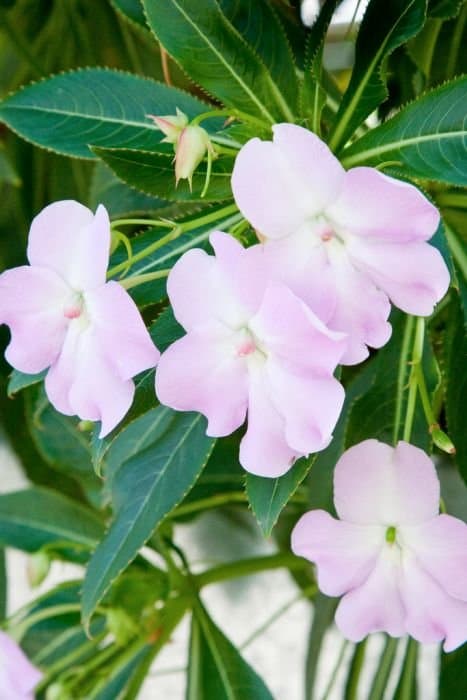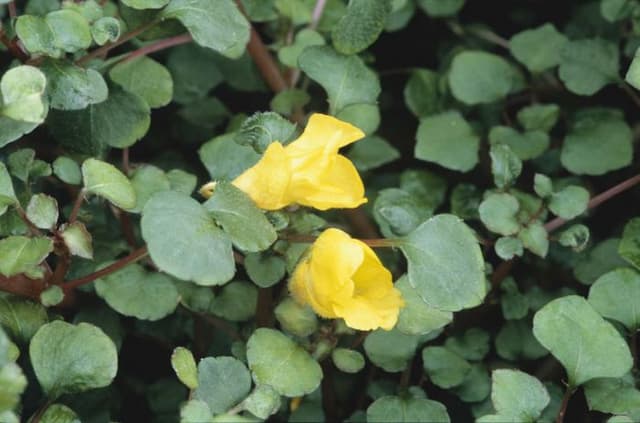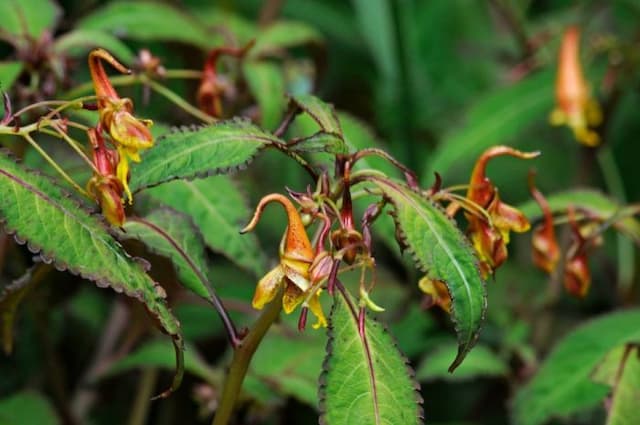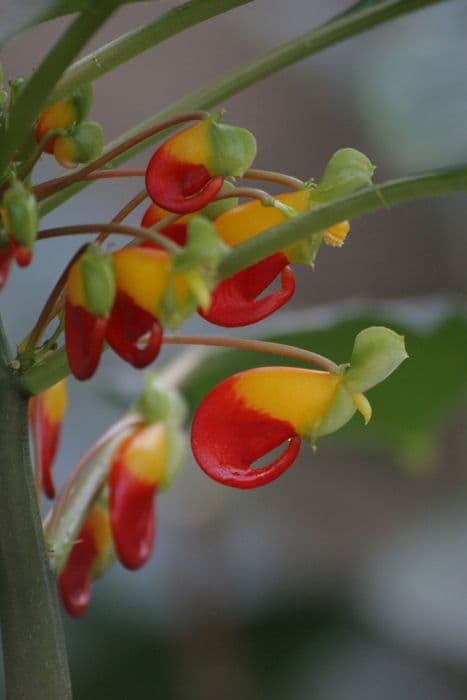Poor Man’s Rhododendron Impatiens sodenii

ABOUT
Impatiens sodenii, commonly known as the "poor man's rhododendron," is a lush, attractive plant renowned for its decorative qualities. This species typically has a robust and bushy appearance, featuring glossy, deep green leaves that can have a slightly toothed margin. The foliage tends to be dense and provides a rich backdrop for the striking flowers. The flowers of Impatiens sodenii are the true stars of the plant, being large, showy, and typically appearing in shades of soft pink to a more vivid magenta. They possess a unique look with a prominent, elongated and curved spur that extends from the rear of the blossom, giving it a distinctive profile. The petals themselves are somewhat asymmetrical, with the lower ones being significantly larger and often arranged in a way that gives the impression of a relaxed, open face. Impatiens sodenii blooms prolifically and can flower for much of the year in the right conditions, making it a popular choice for gardeners looking to add a continuous pop of color to their landscape. Although the size of the plant can be impressive, the visual impact of Impatiens sodenii comes mostly from its floriferous nature and the vibrant contrast between the flowers and the foliage.
About this plant
 Names
NamesFamily
Balsaminaceae
Synonyms
Poor Man's Rhododendron, Impatiens Oliveri, Giant Touch-Me-Not
Common names
Impatiens oliveri, Impatiens kilimanjari, Impatiens sultanii
 Toxicity
ToxicityTo humans
Impatiens sodenii, commonly known as poor man's rhododendron, is not typically considered toxic to humans. However, as with many plants, it is not intended for consumption, and ingesting it may cause mild stomach upset or irritation. There are no severe toxic effects noted for this plant in humans.
To pets
Poor man's rhododendron is not known to be toxic to pets. However, it is generally not advisable for pets to consume plant material, as it can potentially cause gastrointestinal upset or other mild reactions. No serious toxicity symptoms are commonly reported in pets for ingesting this plant.
 Characteristics
CharacteristicsLife cycle
Perennials
Foliage type
Evergreen
Color of leaves
Green
Flower color
Pink
Height
4-6 feet (1.2-1.8 meters)
Spread
2-3 feet (0.6-0.9 meters)
Plant type
Shrub
Hardiness zones
10
Native area
East Africa
Benefits
 General Benefits
General Benefits- Aesthetic Appeal: Impatiens sodenii, commonly known as the "Poor man's Rhododendron," provides vibrant flowers and lush green foliage, enhancing garden beauty.
- Shade Tolerance: It thrives in partially shaded environments where other plants may struggle to grow, making it a good choice for shaded gardens.
- Hummingbird Attractant: The plant's flowers can attract hummingbirds, adding to the biodiversity and natural interest of a garden space.
- Ease of Care: Impatiens sodenii is known for being low maintenance, requiring minimal care once established in the right conditions.
- Rapid Growth: It grows quickly, providing fast coverage and gratification in garden spaces or when used in landscaping.
- Drought Resistance: Once established, it is relatively drought-resistant, making it suitable for gardens in drier climates or for water-conscious gardeners.
 Medical Properties
Medical PropertiesThis plant is not used for medical purposes.
 Air-purifying Qualities
Air-purifying QualitiesThis plant is not specifically known for air purifying qualities.
 Other Uses
Other Uses- Floral Arrangements: Impatiens Sodenii's large, showy flowers are often used in floral arrangements for decorative purposes due to their long-lasting nature when cut.
- Garden Aesthetics: Gardeners may integrate Impatiens Sodenii into ornamental garden designs to add height and a splash of color with its prolific pink blooms.
- Butterfly Attraction: The plant is known to attract butterflies, making it an excellent choice for butterfly gardens and increasing local biodiversity.
- Privacy Screening: Due to its rapid growth and tall stature, Impatiens Sodenii can be planted to create a quick-growing, informal hedge for privacy.
- Container Gardening: This species is suitable for container gardening where ground space is limited, such as balconies and patios.
- Shade Gardening: Impatiens Sodenii thrives in partial shade, making it ideal for brightening up shaded areas in gardens where other plants might struggle.
- Erosion Control: The plant can be used on slopes and banks to help stabilize soil and control erosion due to its fast growth and spreading habit.
- Education and Research: Botanical enthusiasts and researchers might study the plant's growth patterns and breeding to understand better hybridization and genetic diversity in Impatiens species.
- Photography Subject: Due to its striking appearance, photography enthusiasts may use Impatiens Sodenii as a subject to practice macro and nature photography.
- Cultural Celebrations: In some regions, the flowers of Impatiens Sodenii may be incorporated into cultural festivities and celebrations as symbols of beauty and nature's abundance.
Interesting Facts
 Feng Shui
Feng ShuiThe Poor Man's Rhododendron is not used in Feng Shui practice.
 Zodiac Sign Compitability
Zodiac Sign CompitabilityThe Poor Man's Rhododendron is not used in astrology practice.
 Plant Symbolism
Plant Symbolism- Patience: The common name "impatiens" is derived from the Latin word for "impatient," referring to the plant's seed pods which burst open when ripe. Therefore, impatiens are often associated with patience, reminding us to handle situations calmly and with tolerance.
- Endurance: Impatiens sodenii, with its consistent flowering, symbolizes endurance and the ability to persist through challenges with grace.
- Affection: With their bright and numerous flowers, impatiens are seen as a symbol of motherly love, care, and affection, representing a nurturing attitude towards others.
 Water
WaterThe Poor Man’s Rhododendron, should be watered regularly to keep the soil consistently moist but not waterlogged. Typically, this means watering the plant every few days, however, this frequency can vary depending on environmental conditions such as temperature and humidity. During the active growth season in spring and summer, it may require more frequent watering, possibly every 2-3 days. An average guideline would be to provide approximately one gallon of water to a medium-sized plant each week, adjusting based on weather conditions and soil drainage. It's important to reduce watering in the cooler months when the plant's growth slows down.
 Light
LightThe Poor Man’s Rhododendron thrives in bright, indirect sunlight. The ideal spot would be in an area that receives filtered light such as behind a curtain or under the canopy of larger plants. Direct sunlight, especially during the hottest part of the day, can scorch the leaves and should be avoided. A north-facing window or an east-facing location where it can receive gentle morning sunlight would be ideal for this plant.
 Temperature
TemperatureThe Poor Man’s Rhododendron does best in temperatures between 60-75 degrees Fahrenheit. It can survive minimum temperatures of around 50 degrees Fahrenheit, but should not be exposed to temperatures below this as it is not frost-tolerant. The ideal range promotes robust growth and flowering, and it's beneficial to protect the plant from sudden temperature drops and drafts.
 Pruning
PruningPruning the Poor Man’s Rhododendron encourages bushier growth and removes yellow or dead leaves. It should be pruned in the late winter or early spring before new growth begins. Cut back leggy stems to maintain a desirable shape, and remove spent flowers to promote further blooming. It's sufficient to prune this plant once a year, as it helps to keep it healthy and vibrant.
 Cleaning
CleaningAs needed
 Soil
SoilThe best soil mix for Impatiens sodenii, commonly known as Poor Man's Rhododendron, should be well-draining and rich in organic matter. A mix consisting of peat, perlite, and pine bark fines in equal parts can support healthy growth. The ideal soil pH for Impatiens sodenii is slightly acidic to neutral, ranging from 6.0 to 7.0.
 Repotting
RepottingPoor Man's Rhododendron should be repotted every 1-2 years to ensure it has enough space to grow and to refresh the nutrient content of the soil. Younger plants may benefit from annual repotting, while older, larger plants can be repotted less frequently.
 Humidity & Misting
Humidity & MistingPoor Man's Rhododendron thrives in high humidity conditions. It is best to maintain the humidity level around the plant between 50-70% to simulate its natural tropical environment and promote lush growth.
 Suitable locations
Suitable locationsIndoor
Provide bright, indirect light and keep soil moist.
Outdoor
Place in partial shade, protect from direct sun, moist soil.
Hardiness zone
10-11 USDA
 Life cycle
Life cycleImpatiens sodenii, commonly known as poor man's rhododendron, begins its life cycle as a seed that germinates in moist, well-drained soil in a shaded or semi-shaded location. The seedling emerges to develop a fleshy stem and leaves, growing rapidly in favorable conditions of warmth and high humidity. As a young plant, it starts to form characteristic large, lush leaves and may quickly reach its mature size, flowering continuously through the warmer months. The flowers are large and showy, typically lilac in color, attracting pollinators for fertilization. Following successful pollination, the plant produces seed capsules that burst explosively to disperse seeds. In colder climates, Impatiens sodenii behaves as an annual, dying back with the first frost, but in warmer zones, it may persist as a perennial, regrowing from the base after mild winters.
 Propogation
PropogationPropogation time
Spring to summer
For Impatiens sodenii, commonly known as the Shrub Balsam, the most popular method of propagation is by cuttings. This is typically done in late spring to early summer when the plant is actively growing. To propagate, select a healthy, non-flowering stem and cut a 4 to 6 inch (approximately 10 to 15 cm) section. Remove the lower leaves and dip the cut end into a rooting hormone to encourage root development. The cutting should then be placed in a well-draining soil mix, keeping it moist until roots have established. Within a few weeks, the cutting will usually take root, after which it can be transferred to a permanent location. This method is favored for its simplicity and high success rate in producing true to type offspring.
![Busy lizzie [Divine Violet]](/_next/image?url=https%3A%2F%2Fplants-admin.emdemapps.com%2Fimages%2Fplants%2F%2Fimages%2F604b651b90e59.png&w=640&q=75)




![Busy lizzie [SunPatiens Compact Orange]](/_next/image?url=https%3A%2F%2Fplants-admin.emdemapps.com%2Fimages%2Fplants%2F%2Fimages%2F604b5ef883e70.png&w=640&q=75)
![Busy lizzie [SunPatiens Vigorous Magenta]](/_next/image?url=https%3A%2F%2Fplants-admin.emdemapps.com%2Fimages%2Fplants%2F%2Fimages%2F604b622adf631.png&w=640&q=75)


![Busy lizzie [Magnum Wild Salmon]](/_next/image?url=https%3A%2F%2Fplants-admin.emdemapps.com%2Fimages%2Fplants%2F%2Fimages%2F604b589ecbd54.png&w=640&q=75)